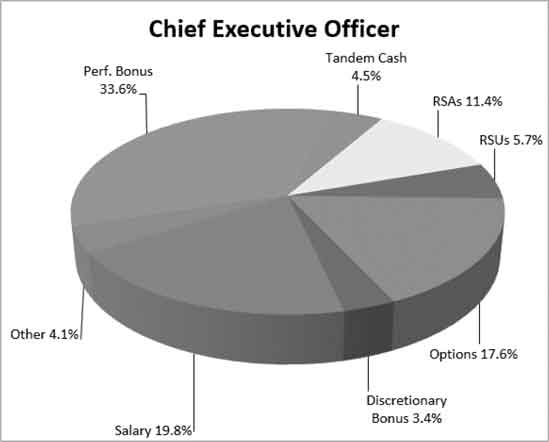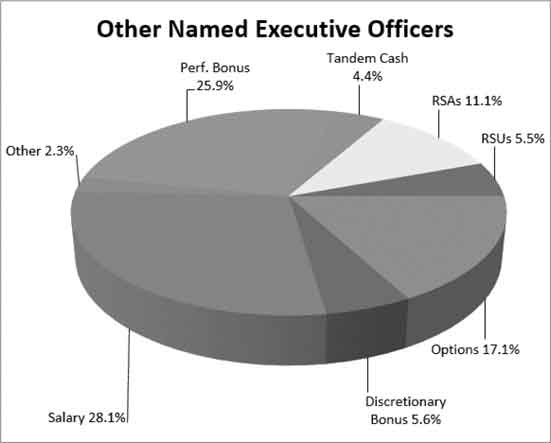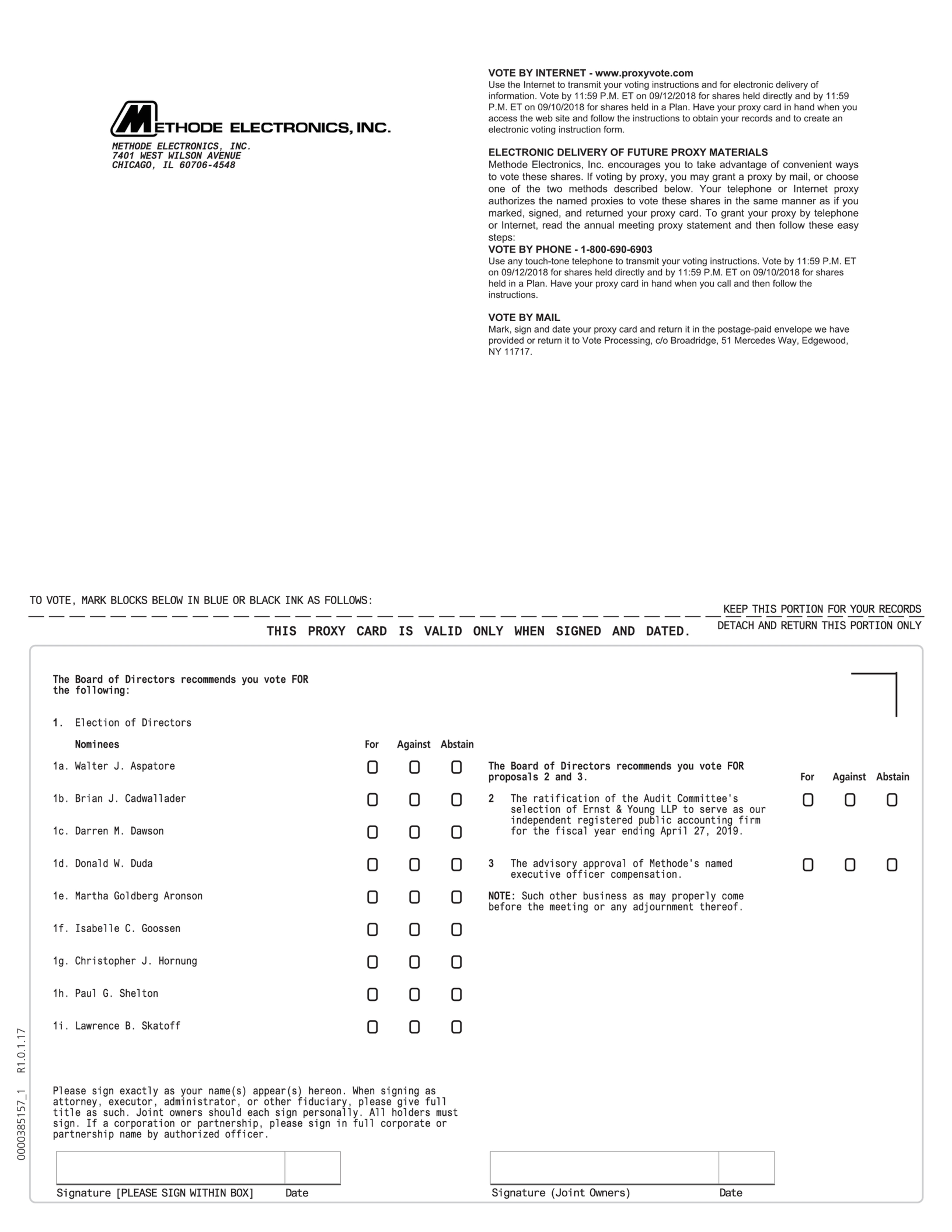In connection with the grantevent of an executive’s death or disability, he or she will earn all of the fiscal 2011 RSAs,Target Shares. In the Compensation Committee granted Tandem Cash Awardsevent of an executive’s qualified retirement, the executive will be eligible to our management team. The amount payable dependsearn a prorated number of shares based on three factors: (i) 2015 IEV; (ii) the number of months during the 60-month performance period that have elapsed prior to retirement and Methode’s actual fiscal 2020 adjusted EBITDA result. In the event of a change of control in which the successor company does not assume the RSAs, earned by the executive (the “RSA Number”); and (iii)will earn a prorated number of the closing price of our common stock as of May 1, 2015 (the “Stock Price”). The performance threshold is 2015 IEV of $600.9 million (the “Tandem Cash Threshold”) and the performance target is 2015 IEV of $726.5 million (the “Tandem Cash Target”).
The following chart sets forth the amounts payableTarget Shares based on 2015 IEV.
| | |
2015 IEV | | Amount of Tandem Cash Awards Payable |
Less Than or Equal to
Tandem Cash Threshold | | None |
| | |
Between Tandem Cash Threshold
and Tandem Cash Target | | 0.4 x RSA Number x Stock Price x |  |
| | |
Greater Than or Equal to
Tandem Cash Target | | 0.4 x RSA Number x Stock Price |
Our 2015 IEVthe number of $1.25 billion exceededmonths during the Tandem Cash60-month performance period that have elapsed prior to the change of control. If the successor company assumes the RSAs and, if the executive is terminated without cause or resigns for good reason within a period of time after the transaction (two years for Mr. Duda and one year for Messrs. Khoury, Kill and Tsoumas and Ms. Barry), then the executive will earn a prorated number of the Target and, therefore, allShares based on the number of our executive officers were entitledmonths during the 60-month performance period that have elapsed prior to a payment equal to 0.4 x their respective RSA Number xtermination of employment. The Compensation Committee believes these provisions regarding the Stock Pricetreatment of $43.59. The amount paid to each of our named executive officers under the Tandem Cash Awards is disclosed belowRSAs in the Summary Compensation Table in the column titled “Non-Equity Incentive Plan Compensation – Tandem Cash.”
event of death, disability, retirement or a change of control reflect fair and reasonable treatment under these scenarios based on current governance best practices and competitive standards.
Time-Based RSUs. The RSUs are subject to a vesting period based on continued service, with 30% vested 20% each year onat the last dayend of Methode’s fiscal year2018, 30% vesting at the end of fiscal 2019, and became 100% vested on May 2, 2015. In order to best align40% vesting at the interestsend of management with our shareholders, sharesfiscal 2020. Following vesting, the delivery of commonthe stock underlying the RSUs will not be delivered to thedeferred for all executive officers other than Ms. Barry until the earlier of the executive’s termination of employment or a change of control of Methode, and the executive iscontrol. Dividend equivalents will not permitted to dispose of these RSUs prior to such event. Dividends were notbe paid on the RSUs until the units have vested. Following vesting and until the delivery of the underlying common stock, each executive iswill be entitled to a quarterly payment in an amount equal to the aggregate per share cash dividend paid during the quarter multiplied by the number of vested RSUs held by the executive. For each executive, these
In the event of an executive’s death or disability, all unvested RSUs represent approximately 20%will become immediately and fully vested. In the event of the shares that would have been awarded overan executive’s qualified retirement, a five-year periodprorated number of RSUs will vest based on historical practices.
Annual Stock Options. Stock options were granted annually from fiscal 2011 through fiscal 2015. The same number of options were grantedthe months during the 60-month vesting period that have elapsed prior to each named executive officer in fiscal 2015 as in each of fiscal 2011, 2012, 2013 and 2014. These options vest one-third upon each of the first, second and third anniversaries of the grant date. For each executive, the aggregate number of options awarded from fiscal 2011 through fiscal 2015 represents approximately 40% of the shares that would have been awarded over a five-year period based on historical practices.retirement. In the event of a change of control in which the successor company does not assume the RSUs, all unvested stock optionsRSUs will become immediately and fully vested.
Five-Year Long-Term Incentive Program Expected to Be Launched in Fiscal 2016
Our Compensation Committee If the successor company assumes the RSUs and, if the executive is currently considering adoptingterminated without cause or resigns for good reason within a new five-year long-term incentive programperiod of time after the transaction (two years for our executive officers consisting of a mix of 65% performance-based restricted stockMr. Duda and 35% time-based restricted stock units.one year for Messrs. Khoury, Kill and Tsoumas and Ms. Barry), then all unvested RSUs will become immediately and fully vested. The Compensation Committee does not currently anticipate awarding stock options or tandem cash awards underbelieves these provisions regarding the new program. Under the proposed program, the vestingtreatment of the performance-based restricted stock will be determinedRSUs in the event of death, disability, retirement or a change of control reflect fair and reasonable treatment under these scenarios based on current governance best practices and competitive standards.
Recent Management Changes
In March 2018, Mr. Hrudicka ceased to be employed by the Company, and Mr. Tsoumas was promoted to Chief Financial Officer. Mr. Kill retired from the Company in May, 2018.
Salary for Mr. Tsoumas. In June 2018, our fiscal 2020 EBITDA, subject to certain potential adjustments, as compared to a threshold, target and maximum performance goal.Compensation Committee reviewed Mr. Tsoumas’ compensation. The Compensation Committee expectsdiscussed Mr. Tsoumas’ promotion and increased responsibilities, reviewed advice from its independent compensation consultant and considered Mr. Duda’s recommendation. The Compensation Committee also considered other relevant factors, including Mr. Tsoumas’ performance, skills and experience, internal pay equity issues and peer comparisons. Based on these factors, the Compensation Committee increased Mr. Tsoumas’ annual salary to adopt$400,000.
Agreement with Mr. Hrudicka. Pursuant to an Agreement and General Release between the new five-year long-term programCompany and Mr. Hrudicka, he is entitled to certain compensation in return for a release of claims and an eighteen-month non-compete covenant. Mr. Hrudicka will be paid his annual salary of $464,000 for eighteen months, in accordance with the second quarterCompany’s regular payroll practices, and $50,000 in connection with his relocation from Quincy, Illinois. Mr. Hrudicka is also entitled to continuing coverage under the Company’s health plan through September, 2019.
Retirement of fiscal 2016. This description ofMr. Kill. Under the five-year long-term incentive program reflects the proposed terms of the programour LTI Program, 37,000 of Mr. Kill’s RSUs vested upon his retirement and he is eligible to earn 55,500 of his RSA shares at this time,target fiscal 2020 performance and these terms are83,250 of his RSA shares at maximum performance. The Company and Mr. Kill entered into a Consulting Agreement with a one-year term, subject to change at the discretion of the Compensation Committee. Following the adoption of the new program, Methode intends to file a Current Report on Form 8-K to report the material terms and conditions of the awards to our executive officers.early termination.
Significant Policies and Procedures
Stock Ownership Policy. Our Compensation Committee considers stock ownership by management to be an important means of linking management’s interests with those of our shareholders. After considering the importance






